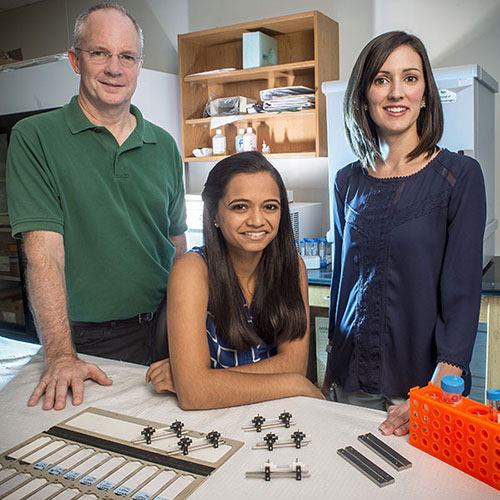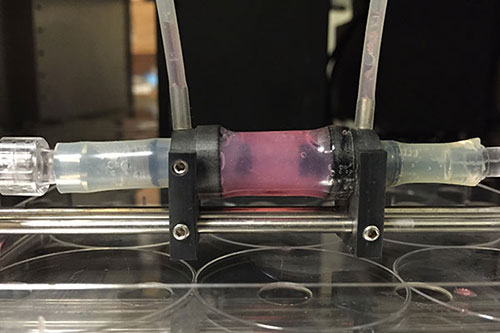Need more information? Contact us
 Team science: Shah is working with Joel Berry (left) and Jillian Richter (right) to create a benchtop model of atherosclerosis that could accelerate drug development. Sections of one of the team’s latest bioreactors are visible in the foreground. Priya Shah was looking for a science project. She found much more — an award-winning study, one-on-one mentoring from a veteran researcher and a leading role in a project that could eventually affect millions — all before graduating from high school.
Team science: Shah is working with Joel Berry (left) and Jillian Richter (right) to create a benchtop model of atherosclerosis that could accelerate drug development. Sections of one of the team’s latest bioreactors are visible in the foreground. Priya Shah was looking for a science project. She found much more — an award-winning study, one-on-one mentoring from a veteran researcher and a leading role in a project that could eventually affect millions — all before graduating from high school.
Shah, now a freshman at UAB and a member of the UAB Honors College’s Science and Technology Honors program, has spent the past year and a half developing a cutting-edge idea in the lab of Joel Berry, Ph.D., an associate professor in the Department of Biomedical Engineering (a joint department of the schools of Engineering and Medicine). Working with Jillian Richter, Ph.D., a postdoctoral fellow in the Department of Anesthesiology and Perioperative Medicine, the team is creating a revolutionary bioreactor — a little black box designed to accelerate the drug development process for treating atherosclerosis, the most common cause of heart disease.
It’s a rare opportunity for any eager young scientist — one made possible by UAB’s world-class research enterprise, mentoring culture and investment in specialized programs focused on student research. “The opportunities you get here to be part of a research team and to get direct mentoring experience as early as your freshman year are pretty unusual across the country,” said Diane Tucker, Ph.D., director of the SciTech Honors program and a professor in the UAB College of Arts and Sciences Department of Psychology.
Fearlessness and serendipity
Last spring, Shah was getting ready for her senior year at the Alabama School of Fine Arts (ASFA). That meant she needed an independent, mentored research project — a graduation requirement for members of ASFA’s math and science track. She knew she wanted to do something in biomedical engineering, but “I also knew from previous experiences that it’s not easy to find someone to take you on,” Shah said. Undaunted, she started looking through the faculty pages on UAB’s Biomedical Engineering department site.
Berry’s work with vascular stents caught her eye, and she sent him an email. After an initial meeting, Shah asked if he would be willing to mentor her. “He said ‘sure,’ which was shocking,” Shah said with a laugh. “I wasn’t expecting it to go so smoothly.” Berry, who is also associate director of the SciTech Honors program, has extensive experience working with promising young people who are fascinated by science. Impressed with Shah’s intelligence, maturity and “fearlessness” in talking with researchers, he had the perfect project in mind.
Berry’s research “centers around devices implanted to replace diseased or damaged tissue in the cardiovascular system — vascular stents and tissue-engineered blood vessels,” he explained. He is also working on tissue-engineered models of breast cancer. “These models are developed from established cell lines, but will eventually be developed from cells extracted from individual patients,” Berry said. The cells are grown in a three-dimensional culture and can be kept alive for weeks at a time by a perfusion system, allowing for patient-specific testing to identify the most effective tumor treatments, he says. The engineered breast cancer research is funded by a grant from the Department of Defense. Berry will seek funding from the National Institutes of Health based on Shah’s work with the atherosclerosis project.
A black box to tackle atherosclerosis
Berry, who came to UAB from Wake Forest University five years ago, had an idea that combined his two research interests. He wanted to develop a tissue-engineered blood vessel — not a pristine vessel, but one filled with fatty, cholesterol-laden plaques. These are the hallmarks of atherosclerosis, “the No. 1 killer of adults in the Western world,” Berry said. An accurate benchtop model of atherosclerosis, derived from human cells, would give scientists searching for new treatments an ideal testing ground compared with the animal models currently used.
 Image of the perfusion bioreactor system used to culture engineered vascular tissue for the atherosclerosis project. A sample of the engineered tissue is seen at center.
Image of the perfusion bioreactor system used to culture engineered vascular tissue for the atherosclerosis project. A sample of the engineered tissue is seen at center.
But Berry, occupied with his other research, hadn’t had time to develop the idea. Richter, also a biomedical engineering graduate of Wake Forest University and postdoctoral fellow at UAB, began investigating the idea with a unique imaging method known as bioluminescence. After Berry and Richter spent some time with Shah, they both realized she was up to the challenge. Shah quickly learned the process of growing cells, how to transfect them with luminescent viruses, which are used to monitor inflammation in the model arteries, and how to image them with a special camera. She also molded the tubes for the centerpiece of the project, the bioreactor: a shoebox-sized device containing three perpendicular, hollow tubes to give the cells a structure to grow on.
Through repeated experiments, Shah and Richter figured out the best ways to induce and measure inflammation in their model system. “You don’t always have to have positive results, but you hope,” Shah said. When she let herself into the lab on a Saturday in December 2014 and saw that their final proof-of-concept experiment was a success, “I was very excited,” she said. “I texted a picture to Jillian and to all my friends. I met my family for lunch and said, ‘Guys, it worked!’”
Building blocks of success
Shah’s efforts have already attracted plenty of attention. She took home a first prize in the Central Alabama Regional Science and Engineering Fair (hosted at UAB), followed by a Best in Show award at the statewide Alabama Science and Engineering Fair. Shah also earned a place in the Intel International Science and Engineering Fair, held in Pittsburgh in May, along with students from more than 75 countries. Discussing her work in front of renowned experts “was exciting and terrifying at the same time,” Shah recalled.
Shah was accepted into schools around the country; but UAB’s Biomedical Engineering and Honors programs, and the connections she had made on campus, clinched the deal for her hometown school. “I had two wonderful mentors, and I’ve been exposed to UAB for the past few years — it made a lot of sense for me,” she said.
“She’s demonstrated an aptitude for science, and all of the personal attributes you need to succeed in science — independence of thought and behavior, and curiosity,” Berry said. Shah will continue to develop these attributes in the SciTech program, Tucker adds. “We work with the students throughout their time at UAB, so we can systematically introduce skills and ways of thinking and approaching problems,” Tucker said. That includes specialized training in everything from lab skills and oral presentations to submitting actual formatted NIH proposals for their research. The students also work together to develop communication and leadership skills “that will allow them to be part of teams that are solving complex problems,” Tucker said.
“Prospective students come and talk to our current students, see what we have to offer, including substantial study abroad and service learning options, and they can visualize themselves being successful here,” Tucker added. “They sense this is a place where they will thrive.”
Investing in ideas — and people
As she settles in for her freshman year, Shah will continue to work on the atherosclerosis project in Berry’s lab. The team now includes two other undergraduate biomedical engineering students (and SciTech program members): Nathan Wells and Ethan Downs. “We’re continuing to gather data that we think puts us in a good position to secure grant funding,” Berry said.
The project has also benefited from a $5,000 investment from the Invention to Innovation (i2i) initiative. This joint collaboration between the School of Engineering and the UAB Collat School of Business, led by business professor Molly Wasko, Ph.D., is designed to support just such high-potential projects. “The benchtop model of atherosclerosis is a great example of the creative work we’re trying to support here at the Collat School of Business through programs such as i2i,” Wasko said. “We believe that students can change the world when given the chance to work collaboratively with discovery scientists and business partners to accelerate science from campus to the community.” The funds have allowed the team to purchase a digital flowmeter and a pressure transducer, which will allow them to verify that their model is producing realistic blood flow and pressures.
“This is a collaboration between multiple departments and schools at UAB — to develop an exciting project, but also to nurture an extremely bright and promising young scientist,” Berry said.